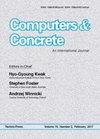Predictive modeling of the compressive strength of bacteria-incorporated geopolymer concrete using a gene expression programming approach
IF 2.9
4区 工程技术
Q2 COMPUTER SCIENCE, INTERDISCIPLINARY APPLICATIONS
引用次数: 2
Abstract
The performance of gene expression programming (GEP) in predicting the compressive strength of bacteriaincorporated geopolymer concrete (GPC) was examined in this study. Ground-granulated blast-furnace slag (GGBS), new bacterial strains, fly ash (FA), silica fume (SF), metakaolin (MK), and manufactured sand were used as ingredients in the concrete mixture. For the geopolymer preparation, an 8 M sodium hydroxide (NaOH) solution was used, and the ambient curing temperature (28oC) was maintained for all mixtures. The ratio of sodium silicate (Na2SiO3) to NaOH was 2.33, and the ratio of alkaline liquid to binder was 0.35. Based on experimental data collected from the literature, an evolutionary-based algorithm (GEP) was proposed to develop new predictive models for estimating the compressive strength of GPC containing bacteria. Data were classified into training and testing sets to obtain a closed-form solution using GEP. Independent variables for the model were the constituent materials of GPC, such as FA, MK, SF, and Bacillus bacteria. A total of six GEP formulations were developed for predicting the compressive strength of bacteria-incorporated GPC obtained at 1, 3, 7, 28, 56, and 90 days of curing. 80% and 20% of the data were used for training and testing the models, respectively. R2 values in the range of 0.9747 and 0.9950 (including train and test dataset) were obtained for the concrete samples, which showed that GEP can be used to predict the compressive strength of GPC containing bacteria with minimal error. Moreover, the GEP models were in good agreement with the experimental datasets and were robust and reliable. The models developed could serve as a tool for concrete constructors using geopolymers within the framework of this research.利用基因表达编程方法对细菌掺入地聚合物混凝土抗压强度进行预测建模
研究了基因表达程序(GEP)预测细菌掺入地聚合物混凝土(GPC)抗压强度的性能。采用高炉磨粒渣(GGBS)、新菌种、粉煤灰(FA)、硅灰(SF)、偏高岭土(MK)和人造砂作为混凝土混合料的原料。制备地聚合物时,使用8 M的氢氧化钠(NaOH)溶液,所有混合物保持环境固化温度(28℃)。水玻璃(Na2SiO3)与NaOH的比例为2.33,碱性液与粘结剂的比例为0.35。基于文献收集的实验数据,提出了一种基于进化的算法(GEP)来建立新的预测模型来估计含细菌的GPC的抗压强度。将数据分为训练集和测试集,使用GEP获得封闭形式的解决方案。模型的自变量为GPC的组成材料,如FA、MK、SF和芽孢杆菌。共开发了六种GEP配方,用于预测细菌掺入GPC在养护1、3、7、28、56和90天时的抗压强度。80%和20%的数据分别用于训练和测试模型。混凝土样品(包括训练集和测试集)的R2值在0.9747和0.9950范围内,表明GEP可以预测含菌GPC的抗压强度,误差最小。GEP模型与实验数据吻合较好,具有鲁棒性和可靠性。开发的模型可以作为本研究框架内使用地聚合物的混凝土施工人员的工具。
本文章由计算机程序翻译,如有差异,请以英文原文为准。
求助全文
约1分钟内获得全文
求助全文
来源期刊

Computers and Concrete
工程技术-材料科学:表征与测试
CiteScore
8.60
自引率
7.30%
发文量
0
审稿时长
13.5 months
期刊介绍:
Computers and Concrete is An International Journal that focuses on the computer applications in be considered suitable for publication in the journal.
The journal covers the topics related to computational mechanics of concrete and modeling of concrete structures including
plasticity
fracture mechanics
creep
thermo-mechanics
dynamic effects
reliability and safety concepts
automated design procedures
stochastic mechanics
performance under extreme conditions.
 求助内容:
求助内容: 应助结果提醒方式:
应助结果提醒方式:


